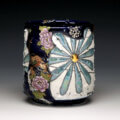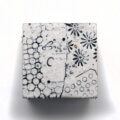
Gillian Parke graduated from Boston University with a BA in chemistry. Gillian continues to work in chemistry at Duke University/Durham VA Medical Center researching the quantitation of neurosteroids Her journey with clay began in 1995 with a wheel throwing class offered through the Parks and Recreation Department of Chapel Hill. After spending a year taking courses towards a MFA in ceramics at East Carolina University, Gillian returned to Durham where she currently has a studio. In 2008 she received an Emerging Artist Grant from the Durham Arts Council. She was chosen by Ceramics Monthly Magazine as one of 13 Emerging Artists in 2008 and was featured as a cover artist in the February 2009 issue.
Gillian Parke’s work explores the fusion of rough and fine textures and surfaces into complete pieces of ceramics. Completed works are fired four to twelve+ times at various temperatures. Her work is in numerous public and private collections including the San Angelo Museum of Art and the Mint Museum in Charlotte, NC.
Fine bone china and porcelain are frequently associated with treasured heirlooms that are passed down between generations. My association with porcelain stems from early childhood summer trips to visit my grandmother in Northern Ireland, where she would take me to local china shops to buy small porcelain souvenirs. As I pursued my ceramic education, and started working with porcelain, these memories came to the forefront to influence both my techniques and directions.
My current work combines elements of manufactured porcelain and Japanese pottery, particularly Shigaraki and Imari ware. Fine porcelain is highly processed and purified, mass-produced, and fired in a controlled manner using saggars, effectively removing any evidence of an individual artist. In contrast, Shigaraki ware is typically handmade stoneware with feldspar inclusions fired in an anagama kiln, the only decoration coming from the randomness of wood ash. Imari is highly decorated porcelain that was for the export market. My surface designs focus on the Imari ware patterns and motifs used to meet aesthetic tastes outside Japan
In my work, feldspar inclusions are added to porcelain and the resulting surfaces are achieved through a combination of an unpredictable atmospheric gas firing and reliable electric firing. The conflict is further explored by incorporating open-stock decals and metallic lusters, which had been overlooked by modern studio potters as feminine hobby materials. I am interested in the conflict created by kitsch images on handmade objects, and in challenging the aesthetics and values presented when using such materials unconventionally. The resulting works illustrate the contrasts in aesthetics, forms, traditions, and function found between Japanese pottery and European fine porcelain. Through the application of underglazes, overglazes and decals, the textures are further enriched to give a more visceral surface not often associated with porcelain.
Description of Material and Technique
My work is wheel thrown & altered porcelain & porcelain with feldspar/molochite inclusions. Pieces are assembled, dried then resists & underglazes used to develop the surface. After gas reduction firing (cone 10), layers of decals and lusters are added requiring multiple electric firings (cone 017).












